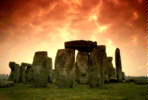Although commonly pictured as a single stone circle it actually consists of a series of circles and post holes that succeeded each other over thousands of years; the construction has been radio-carbon dated to originate from at least 3,100 BC.
From the outside to the centre Stonehenge consists of:
The extent of the stone- and earth-works at this site and the centuries that each construction phase covers demonstrate the major significance this site had for the many generations of people that built and used it. The main sarsen stones have been fashioned with the most primitive of tools (deer antler tools have been found in some of the stone holes) with enormous time and effort instead of leaving them as unfinished natural stones. The upstanding sarsens have been ground to taper upwards, ostensibly to counter the optical illusion of converging verticals to give a more pleasing appearance. The lintels have been laid with mortice and tenon joints to secure them to their 7-metre tall, 45-ton uprights instead of simply laying them across their supporting sarsens. The sarsen stones had been brought from the Marlborough Downs to this particular point in England, emphasising this particular place's importance to its builders. The bluestones had been brought from even farther afield from the Prescilli mountains in South-west Wales. The surrounding area is full of further remnants and earthworks including Woodhenge and the Cursus which again emphasises the importance of this area.
Stonehenge was almost certainly built as an astronomical observatory principally for the summer & winter solstices and the lunar cycles. The arrangement of the stones; the axis of the construction leading to the North-East; the Avenue leading to the construction from the North-East; the alignment of the sun at summer solstice over the Heel Stone that is not precisely over the Heel Stone nowadays but must surely have been at its building given the lean that the Heel Stone has acquired and the change in alignment between the sun and Earth over the millennia; the discovery of further stone and post holes in the surrounding area that align with lunar cycles. All of these factors collectively, and irrefutably in my view, point to the construction being a neolithic computer for measuring, recording and predicting the sun's and moon's cycles that would have held such significance to the agriculture of the peoples who made it.
Some have claimed religious or cult significance for the site. Amongst the most well-known, and the most ridiculous, is that of the Druids who claim it as a Druidic temple despite Stonehenge's construction pre-dating the existence of Druids by at least 3,000 years and its construction and siting having nothing to do with the typical Celtic themes of wood and water.
Despite its now ruinous state, this is a very impressive building in a beautiful part of the world that impresses in its own right as well as the fact that it has survived such a very long time and is the result of such a huge level of commitment and innovation on the part of its original designers and builders.

